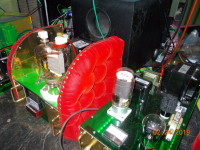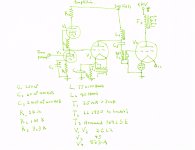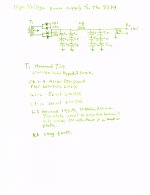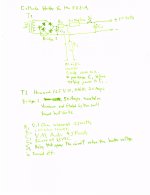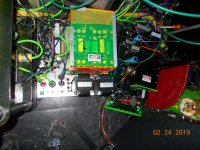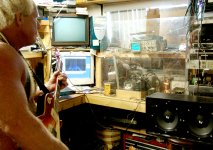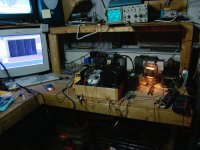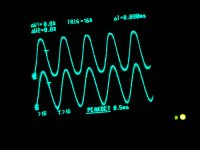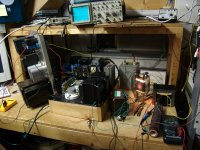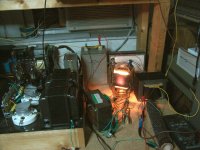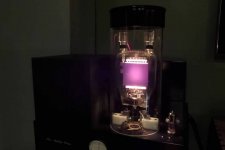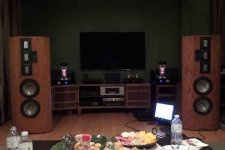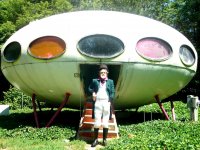I have completed and perfected my magnum opus, an 833-A single ended triode amplifier which drives a pair of Magnepan 0.7's. It is one and a half years in the making. I am interested in guiding anyone who would like to use this wonderful triode which I consider the Stradivari of vacuum tubes for music. It works best at 1000 Volts with zero grid bias where on the chart it is just as linear as it is at any other voltages, something I verified by using batteries to test both positive and negative bias applied to the grid which had the effect of symmetrical changes in plate current with respect to grid voltage, +1.5 Volts raised the plate current by 8 ma and -1.5 Volts lowered it by 8 ma. It sounds best at zero grid bias which causes the tube to draw 110 ma.
It costs well under $2000 to build a pair of these and it uses Hammond 1642SE output transformers rated to carry 300ma pot tested to 4kV. I drive it with Lundahl LL2765 transformers to step down from about 5k to 500 Ohms on the grids. The 1000Volt plate supply is straight forward with proper caging for safety and fuses on the power transformers and the 833-A cathode requires a very well filtered 10 Volts DC at 10 Amps for which I use 4.5 Farad filter capacitors which pre-charge before turning it on.
It costs well under $2000 to build a pair of these and it uses Hammond 1642SE output transformers rated to carry 300ma pot tested to 4kV. I drive it with Lundahl LL2765 transformers to step down from about 5k to 500 Ohms on the grids. The 1000Volt plate supply is straight forward with proper caging for safety and fuses on the power transformers and the 833-A cathode requires a very well filtered 10 Volts DC at 10 Amps for which I use 4.5 Farad filter capacitors which pre-charge before turning it on.
Attachments
The sides of my final stage amplification chassis are covered with red velvet over foam rubber with sunken buttons and the edges secured with upholstery tacks from the hardware store. I made it in the style of steampunk out of a Jules Verne novel. I encourage builders to build their amplifiers in their own favorite style. Here is a schematic.
 Please learn how to upload images properly: How to attach images to your posts.
Please learn how to upload images properly: How to attach images to your posts.> No voltage equalizing resistors
If electrolytic, all from the same lot, it will be OK, for a while. One gets higher voltage, which increases its leakage, which reduces its voltage.
I'd be more interested in the 1Meg 1/2 Watt "bleeder". Few 1/2W resistors are rated over 350V long-term. (Also it does not bleed much... 90 seconds to reach 50V; _IF_ the resistor hasn't failed from voltage stress.)
If electrolytic, all from the same lot, it will be OK, for a while. One gets higher voltage, which increases its leakage, which reduces its voltage.
I'd be more interested in the 1Meg 1/2 Watt "bleeder". Few 1/2W resistors are rated over 350V long-term. (Also it does not bleed much... 90 seconds to reach 50V; _IF_ the resistor hasn't failed from voltage stress.)
It has been over a year and a half. I just put enough of them in series to have them overrated. So far, no signs of trouble. www.mouser.com and www.digikey.com have resistors which are rated at the voltages needed. I wish I could find capacitors rated so I did not have to put them in series because, if nothing else, it would be more convenient.
Attachments
DC Link film caps come in > 1000 vdc as well as lower. Some reckon they sound better than electrolytics in power supplies. Certainly they are more convenient.
DC Link Film Capacitors Film Capacitors | Mouser
ray
DC Link Film Capacitors Film Capacitors | Mouser
ray
That poor ½ watt, 1,000 kΩ resistor! P = E²/R = 1000² ÷ 1,000,000 = 1 watt. I definitely recommend replacing with a string of ½ watt, 220 kΩ resistors… 4 of them would be about right.
While you're at it, use 330 kΩ resistors across each filter capacitor. Cheap, easy, the kind of thing that other posters have already talked about.
And if you are into making a few subtle corrections, the 10 volt, 10 amp supply has the switch kind of on the wrong side of the 4.5 F supercapacitor. I saw on the first page that the 4.5 F is “precharged”.
Lastly, I'm wondering, what the heck the 100 kΩ resistor is on the amplifier's 'top' 2C22 valve anode. You seem to be using choke loading (which I admire), so what's the 100 kΩ for?
Post-lastly, I kind of wonder what the quiescent 833 anode dissipation is. It apparently has a 100 watt thoriated tungsten filament, and at least one source says that “normally, the anode glows deep red”. Is this true, or does the 100 W TTF glow outshine the anode?
I like the padded red velvet touch. Has that nice 1950s homey look about it. Brass tacks, too. Cool. Now... if each monoblock could be housed in a nice Faraday cage...
Just saying,
GoatGuy ✓
While you're at it, use 330 kΩ resistors across each filter capacitor. Cheap, easy, the kind of thing that other posters have already talked about.
And if you are into making a few subtle corrections, the 10 volt, 10 amp supply has the switch kind of on the wrong side of the 4.5 F supercapacitor. I saw on the first page that the 4.5 F is “precharged”.
Lastly, I'm wondering, what the heck the 100 kΩ resistor is on the amplifier's 'top' 2C22 valve anode. You seem to be using choke loading (which I admire), so what's the 100 kΩ for?
Post-lastly, I kind of wonder what the quiescent 833 anode dissipation is. It apparently has a 100 watt thoriated tungsten filament, and at least one source says that “normally, the anode glows deep red”. Is this true, or does the 100 W TTF glow outshine the anode?
I like the padded red velvet touch. Has that nice 1950s homey look about it. Brass tacks, too. Cool. Now... if each monoblock could be housed in a nice Faraday cage...
Just saying,
GoatGuy ✓
does the 100 W TTF glow outshine the anode?
Both are quite visible but different color. In these pictures the tube is dissipating about 400 watts and as stated the filament gets 100 watts. The plate glows red at idle.
Note: Don't try this at home.....that power supply (standing vertically on its 75 pound transformer) was lifted from a radio transmitter and is rated for 1500 volts at 1/2 Amp.
This was a temporary setup to test the custom spec OPT I had made. It only existed for 1 week and there was a Lexan "blast shield" between me and it for testing (removed only for pictures since it was pretty scratched up). All pictures except the abuse test were taken with the overhead shop lights off. There is still plenty of ambient light in the room. The abuse test had 160 watts of fluorescent shop lights overhead. This washed out the filament glow since the color temperatures were similar. The red plate glow was still visible. Note that it's IR emission could be felt almost anywhere in the room.
Scope shows input (bottom) and speaker output (top) at 200 watts output. Plate glow is nearly gone at this level since the dissipation drops to about 200 watts.....400 watts DC input, 200 watts of audio output.
I performed the "serious abuse" test with a guitar preamp and speakers. It could be heard from two blocks away.......yes, this obviously happened quite some time ago. In several of these abuse tests the worse that happened was a tripped bench breaker twice. I could find a tempo with my guitar playing that excited a resonance in the power supply somewhere in the 2 Hz range. Continued playing at this tempo started pulsating the bench and room lights and eventually tripped the 15 amp bench breaker.
Attachments
I measured the Voltages on the output of the lower 2C22 (a few years ago when I was running it as a 45 SET to get it to match the Voltage on the 45 grid to eliminate the coupling capacitor) and it took the 100k on the upper 2C22 to get that match using the same B+ for the driver of the 45. I later replaced the 45 output transformer with several transformers I tried out to drive the 833-A grid, a Hammond which did not step down enough, a choke capacitor coupling, a Lundahl in parallel feed which sounded good but was too thin sounding, and finally the LL2765 which has a rich full-bodied sound. A Sowter would probably work just as well at about the same price.
I the bleeder resistors are much bigger and rated at some 2 or 3 Watts and I remember it rated to several thousand volts. The way I mounted the capacitors in Plexiglas with holes drilled and soldered wires filling in and anchoring the holes because I could not find ring mounts for them made it too difficult to solder bleeder resistors in each one of them. I wish I had known about available film capacitors available at 2 kV ratings. It would have been easier to build.
I can't see any red glow in the anodes because the cathodes light up so bright. I like to run these tubes gently because distortion sets in when tubes are pushed hard, at easy going current well below up to 300 Watts maximum continuous dissipation, the electrode seals eventually give way and the tube loses its vacuum. More than once I tried used 833-A tubes used from ebay and this is how they had lost their vacuum.
Wendell Dillard and his wife toured all the big stereo shops demonstrating their Magnepan speakers and I showed pictures of my amplifiers to them. They warned of how such an amplifier would fail the wife-acceptance-factor so I suggested a strategy: Show a wife pictures of the Bulgarian designed GM-100 SET, with tubes one meter tall and an exposed 4 or 5kV finned anode caps. When she says "Hell no!" offer to compromise and get a pair of more modest 833-A monoblocks.
The 833-A gets ridiculed from both directions. SET purists who esteem 1 or 2 Watt SET-sensitive horn speakers call people who like the SET but also like insensitive speakers Vikings while the Bulgarians who make GM-100 amplifiers denounce people who use mere 833-As as whimps. I guess the 833-A is for middle of the road people like me.
I the bleeder resistors are much bigger and rated at some 2 or 3 Watts and I remember it rated to several thousand volts. The way I mounted the capacitors in Plexiglas with holes drilled and soldered wires filling in and anchoring the holes because I could not find ring mounts for them made it too difficult to solder bleeder resistors in each one of them. I wish I had known about available film capacitors available at 2 kV ratings. It would have been easier to build.
I can't see any red glow in the anodes because the cathodes light up so bright. I like to run these tubes gently because distortion sets in when tubes are pushed hard, at easy going current well below up to 300 Watts maximum continuous dissipation, the electrode seals eventually give way and the tube loses its vacuum. More than once I tried used 833-A tubes used from ebay and this is how they had lost their vacuum.
Wendell Dillard and his wife toured all the big stereo shops demonstrating their Magnepan speakers and I showed pictures of my amplifiers to them. They warned of how such an amplifier would fail the wife-acceptance-factor so I suggested a strategy: Show a wife pictures of the Bulgarian designed GM-100 SET, with tubes one meter tall and an exposed 4 or 5kV finned anode caps. When she says "Hell no!" offer to compromise and get a pair of more modest 833-A monoblocks.
The 833-A gets ridiculed from both directions. SET purists who esteem 1 or 2 Watt SET-sensitive horn speakers call people who like the SET but also like insensitive speakers Vikings while the Bulgarians who make GM-100 amplifiers denounce people who use mere 833-As as whimps. I guess the 833-A is for middle of the road people like me.
I thought of that but the ending of Wagner's Ring Cycle inspired me to chicken out. A GM-100 exceeds my acceptance factor, let alone wife-acceptance-factor. But then my house I am warned most wives would never tolerate. Maybe that has something to do with my marrying later in life.
Attachments
I can't see any red glow in the anodes because the cathodes light up so bright. I like to run these tubes gently because distortion sets in when tubes are pushed hard, at easy going current well below up to 300 Watts maximum continuous dissipation, the electrode seals eventually give way and the tube loses its vacuum. More than once I tried used 833-A tubes used from ebay and this is how they had lost their vacuum.
If the seals fail when operated under 300W dissipation, there is probably not enough airflow to keep them cool. Is there enough space around the 833's and convection from below?
The anode is supposed to glow dull red: the zirconium getter deposited on the anode only works above a minimum temperature. No glow means no getter function resulting in a gassy 833.
- Home
- Amplifiers
- Tubes / Valves
- My 833-A amplifier
